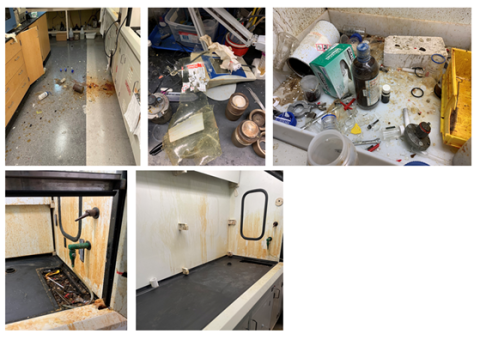
Late one evening, the EH&S On-Call Number received an urgent call about a loud bang and a chemical spill involving an unidentified substance. Upon arriving at the scene, our Hazardous Materials Specialist found broken glass bottles and debris scattered across the floor, within the chemical fume hood, and throughout the laboratory. The sash of the chemical fume hood was visibly cracked along its length, and a computer screen had also been shattered. Lab personnel mentioned that just minutes prior to the noise, a student had been handling nitric acid near containers with a mixture of various organic solvents, including acetone, DMSO, ethanol, and sodium sulfide.
The root cause of this accident is believed to be a mixture of nitric acid waste and organic solvent waste. A lab member accidently added the nitric acid waste to the organic solvent waste, placed the cap on top of the bottle, then left the lab. Shortly after leaving, the loud noise was reported. There were at least four 1-L glass bottles that were shattered. Due to the extent of the incident, the lab was closed for two days to be professionally cleaned by a third-party contractor.
Nitric acid is a chemical that is frequently involved in reactive incidents. It must be physically segregated from organic solvents and all other acids. Contact between a broken organic solvent bottle and a container of nitric acid can lead to the release of nitric acid fumes and a potential explosion. Improper waste handling is an area of great concern in research laboratories where there are many lab members conducting experiments. Improper or inadequate labeling of waste containers can lead to the mixing of incompatible chemicals and can result in unwanted and possibly runaway reactions. These reactions could cause serious property damage, personal injury, or worse. Luckily, no one was injured in this incident. The lab members did an excellent job providing EH&S with information about the various solvents being used and the waste stream.
When an incident or near miss such as this occurs, EH&S should always be informed – even in situations like this where the imminent hazard (fire) has been mitigated. A phone call to the EH&S On-Call Number @ (404) 216-5237 will ensure that the proper EH&S team follows up and supports the person or group immediately.
